Researchers claim that a group of massive young dwarfs with short and busy lives passed too close to the solar system a few million years ago. One or more of them could have exploded and harmed life on Earth
Avi Blizovsky

When gathering together data collected in astronomical observations, in planetary comparisons and from geology, scientists today offer a claim that a supernova caused damage to the ozone layer on Earth and, as a result, mass destruction of life on Earth. The researchers claim that a group of massive young dwarfs with short and busy lives passed too close to the solar system a few million years ago.
No one had noticed that this star cluster could have been so close to Earth at any time, says astronomer Narisco Benitez. Benitez, along with his partner Jesus Maiz-Appellanis, scoured the geological record for evidence of such a transition.
"When I started the research, I discovered a find from 1999. A group of German researchers found an unusual variety of iron in samples dug up from the earth's crust under the ocean floor. The Germans claimed that the iron originated in a supernova, but they knew that there was no suspected star that exploded near the Earth when the metal landed on the Earth. Benitez said.
However, Benitez and Mays Aplanis have done some detective work and are now claiming a solution to the problem. A compact star cluster known as the OB Scorpius Centaurus star that passed by the Solar System a few million years ago.
Benitez's wife, Matilda Canales was appointed to look for fossils for evidence. Canales found strong evidence of a mass killing of sea creatures about two million years ago. Her husband estimated that the Scorpius Santaros were very close to the Earth at that time, so that if one of them exploded and became a supernova, the tremendous energy released from it would tear the ozone layer that protects life on Earth from the sun's ultraviolet radiation.
This may create a significant decrease in the concentration of phytoplankton and the general biomass, and this immediately affects the rest of the marine food chain. The scientists estimate that further research is needed to confirm the theory, however if it proves to be correct, there is no longer any need to be concerned about the Scorpius Centaurus group. Their next friend that could become a supernova is Antares, which is 500 light-years away from us, far enough for the blast from the supernova not to hit Earth. they say.
